Project results
Summary of results
There has been a worrying increase in coal mine dust lung disease over the last 20 years in the USA and Australia which, although there is very little data, is likely to be the same in Europe. To help address this, the EU-funded ROCD project (2017-2020) has developed new assessment protocols to determine the concentration, physical and chemical characteristics and toxicity of dusts in European underground coal mines, and the effectiveness of currently used dust masks. In addition, it has produced working prototypes of new dust monitoring and dust control devices suitable for use in explosive environments.
The coal dust assessments were carried out on dust particles with a diameter less than 10 um (so called PM10), less than 4 um (so called PM4), and for the first time in a major European study, less than 2.5 um (PM2.5). The PM4 and PM2.5 particles are so small, less than 0.01 of a mm, that they can be breathed in to the gas-exchange regions of the lungs. It is possible that long exposure to high levels of such particles may cause cardiopulmonary as well as occupational lung diseases.
From mineralogical, chemical and toxicological studies of dusts from the Polish and Slovenian mines, PM4, and especially PM2.5, were found to have elevated concentrations of potentially harmful substances and were toxic to cultured human lung cells. Although these results cannot be directly related to levels of disease in humans, it is very likely that if unprotected, mine workers will suffer adverse health effects from exposure to coal dusts.
Currently used dust masks can, if worn properly, give workers a good level of protection against PM2.5 and PM4, however from visits to certain mines during 2017 and 2018, workers in some situations only wear their masks when they perceive high concentrations of dust, unaware of their constant exposure to PM2.5 which is invisible. The recommended actions to address this are education and training to increase awareness of the potential risks from coal dust, and a zero-tolerance towards the non-wearing of masks underground.
Always wear a mask when working in potentially dusty environments!
The aims of the ROCD project were to address three main issues in the European coal mining industry:
- Limited modern data on the concentrations, nature and possible toxicity of coal dust, particularly for PM2.5;
- The urgent need for better continuous dust concentration monitoring and control systems, modern quantitative physicochemical and toxicological assessment protocols for coal dust particles and predictive tools to assess dust hazards in different mining scenarios;
- Whether dust control technologies and respiratory protective masks adequately protect workers.
Two case-study areas were selected which are representative of underground coal mining in Europe: the Upper Silesian Coal Basin of Poland and the Šaleška valley of Slovenia. The Polish mines work hard coal deposits using traditional longwall mining methods. The Slovenian coal mine works lignite from one of the thickest (average 60 m) known coal seams in the world, which requires a specialised “Velenje” mining method, which produces particularly high concentrations of dust.
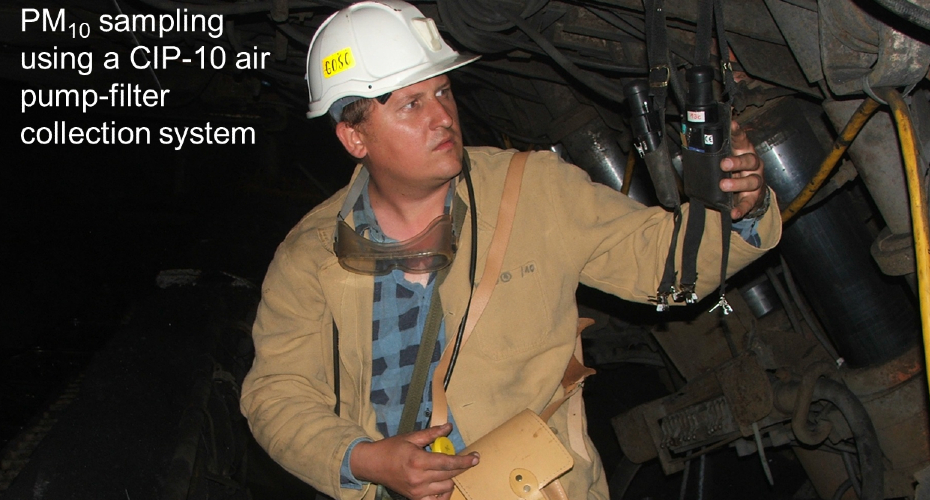
The main approaches used in the project were:
- Workers were asked to fill in questionnaires on their perceptions of the usefulness of current systems for controlling dusts underground and respiratory protective masks;
- Dust collection underground, including deposited (time referenced), accumulated (long-term, non-time-referenced) and airborne dust (total particulate and PM10);
- Coal dust particle size segregation into PM10, PM4 and PM2.5 using a recently patented device (Patent No. 201131895);
- Modern chemical, mineralogical and toxicological analysis of different size fractions of coal dust, including PM2.5;
- Development of new devices for dust concentration measurements, monitoring and collection, and for dust control underground;
- Performance testing of currently used dust masks, particularly for PM2.5;
- Development and testing of a range of new training and learning tools for underground coal workers, management and authorities, emphasising the importance of the proper use of dust control systems and respiratory protective masks;
- Design of outreach materials to optimise the dissemination of results from the ROCD project.
Coal mining has long been associated with a variety of preventable coal mine dust lung diseases, the most common of which is pneumoconiosis, literally dusty lung, which includes a number of incurable and often fatal diseases such as coal workers’ pneumoconiosis (CWP, or ‘black lung’) and silicosis1. Due to huge efforts in the USA to mitigate CWP, the proportion of miners with more than 25 years’ experience diagnosed with this dropped from approximately 33% in the early 1970s to less than 5% in the late 1990s. Since then, however, incidences of CWP have rebounded in the USA by over 10% for the longest serving miners1, and a similar trend has been seen in Australia2. Most worrying is that less experienced US workers, who have spent their whole careers under modern mine regulations, show a higher prevalence of lung disease than miners who began work before 1970, when the regulations came into place3.
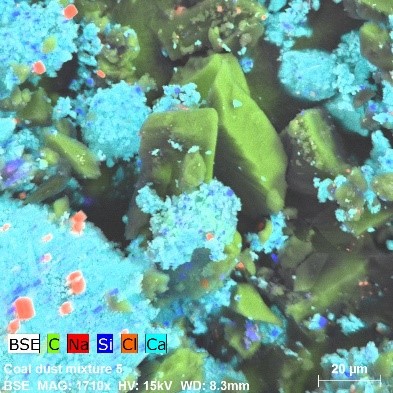
Figure 1 - False colour chemical map overlain on scanning electron microscopy image showing limestone dust particle aggregates (‘rock dust’, light blue) attached to coal dust (green). Sample from a lignite mine in Slovenia.
Unfortunately, there is little modern data available for incidences of CWP in Europe. The reason for this is unclear and could be manifold, perhaps relating to a false perception that CWP is no longer an issue in modern coal mining, or because of the general decline in the industry and therefore tighter financial constraints. That there is a problem in certain European countries was indicated by Zlotkowska and co-workers4 who stated that in the period 2003-2011 there were 3,723 cases of CWP diagnosed amongst coal mine workers in Silesia, Poland.
There are numerous possible reasons for the apparent increase in CWP in at least some countries, the most likely being related to changes in mining practices underground. In Australian mines, it is blamed on a “potential decline in dust exposure control or a failure of health screening processes, or both”5. In the USA, it has been suggested that miners working in smaller mines and spending longer hours at the coalface are at greater risk of developing rapidly progressive CWP6,7,8. Another consideration is that modern, commonly diesel-powered mining equipment, whilst more efficient for coal production, may create toxic particulate underground9. Worryingly, from visits to two European underground coal mines in 2017-18, many workers are simply not always wearing their dust masks. The likely reasons for this, according to managerial staff, is that miners either find it uncomfortable to wear a mask, see it as a weakness, or say that it reduces their breathing capacity during hard work.
Of additional concern in the current study is that coal workers may be suffering unrecognised health impacts (possibly including cardiopulmonary diseases) from exposure to fine particulate matter (PM2.5), in addition to occupational lung diseases such as CWP. PM2.5 is dust particles nominally less than or equal to 2.5 µm in diameter, which can be breathed into the alveolar regions of the lungs10. In urban air pollution studies, increased atmospheric concentrations of PM2.5 have been linked to higher rates of cardiovascular- and respiratory-related deaths11,12: “There is no evidence of a safe level of exposure or a threshold below which no adverse health effects occur”11. An assessment is therefore urgently required as to the levels and nature of PM2.5 in underground coal dust, and whether this may contain higher concentrations of potentially toxic substances such as certain metals, e.g. Fe and Ni, minerals including quartz13 and organic-based toxins. Few previous studies have considered PM2.5, mainly because of difficulties inherent in its collection, sample size separation from whole-dust and physical and chemical characterisation. There are also few underground dust control devices and dust masks which have been tested for PM2.5.
- NIOSH, 2019. Mining Topic: Respiratory Diseases - What is the health and safety problem? https://www.cdc.gov/niosh/mining/topics/RespiratoryDiseases.html (viewed 17/2/2020).
- Perret, J., Plush, B., Lachapelle, P., Hinks, T.S.C., Walter, C., Clarke, P., Irving, L., Brady, P., Dharmage, S.C. and Stewart, A., 2017. Coal mine dust lung disease in the modern era. Respirology 22, 662-670. (and references therein)
- Graber, J.M., Harris, G., Almberg, K.S., Rose, C.S., Petsonk, E.L., Cohen, R.A., 2017. Increasing severity of pneumoconiosis among younger former US coal miners working exclusively under modern dust-control regulations. J. Occup. Environ. Med. 59: 105-111.
- Zlotkowska, R., Mroczek, A. and Hudzik, G., 2013. Epidemiological analysis of the incidence and risk factors for coal-workers' pneumoconioses in the Silesia, Poland during period 2003-2011. European Respiratory Journal, 42: abs. P1001. Available at: https://erj.ersjournals.com/content/erj/42/Suppl_57/P1001.full.pdf [accessed May 2020].
- Zosky, G.R., Hoy, R.F., Silverstone, E. J., Brims, F. J., Miles, S., Johnson, A.R., Gibson, P. G. and Yates D. H., 2016. Coal workers’ pneumoconiosis: an Australian perspective. Med. J. Aust. 204, 414-418.
- Seaton, A., Dodgson, J., Dick, J.A. and Jacobsen, M., 1981. Quartz and Pneumoconiosis in Coalminers. Lancet 318, 1272-1275.
- Kenny, L.C., Hurley, F., Warren, N.D., 2002. Estimation of the risk of contracting pneumoconiosis in the UK coal mining industry. Ann. Occup. Hyg. 46, 257–260.
- Antao, V.C., Petsonk, E.L., Sokolow, L.Z., Wolfe, A.L., Pinheiro, G.A., Hale, J.M. and Attfield, M.D., 2005. Rapidly progressive coal workers’ pneumoconiosis in the United States: geographic clustering and other factors. Occup. Environ. Med. 62: 670–4.
- Petsonk, E.L., Rose, C. and Cohen, R., 2013. Coal mine dust lung disease: New lessons from an old exposure. Am. J. Respir. Crit. Care Med. 187, 1178-1185.
- Li, D., Li, Y., Li, G. and Zhang, Y., 2019. Fluorescent reconstitution on deposition of PM2.5 in lung and extrapulmonary organs. PNAS, 116 (7) 2488-2493.
- WHO, 2013. Health effects of particulate matter: Policy implications for countries in eastern Europe, Caucasus and central Asia (ISBN 978 92 890 0001 7). https://www.euro.who.int/__data/assets/pdf_file/0006/189051/Health-effects-of-particulate-matter-final-Eng.pdf (accessed: 11/6/2021)
- Liu, C., Chen, R., Sera, F., Vicedo-Cabrera, A.M., Guo, Y., Tong, S., Coelho, M.S.Z.S., Saldiva, P.H.N., Lavigne, E., Matus, P., Valdes, O.N., Osorio Garcia, S., Pascal, M., Stafoggia, M., Scortichini, M., Hashizume, M., Honda, Y., Hurtado-Díaz, M., Cruz, J., Nunes, B., Teixeria, J.P., Kim, H., Tobias, A., Íñiguez, C., Forsberg, B., Åström, C., Ragettli, M.S., Guo, Y.-L., Chen, B.Y., Bell, M.L., Wright, C.Y., Scovronick, N., Garland, R.M., Milojevic, A., Kyselý, J., Urban, A., Orru, H., Indermitte, E., Jaakkola, J.J.K., Ryti, N.R.I., Katsouyanni, K., Analitis, A., Zanobetti, A., Schwartz, J., Chen, J., Wu, T., Cohen, A., Gasparrini, A., Kan, H., 2019. Ambient particulate air pollution and daily mortality in 652 cities. N. Engl. J. Med., 381, 705-715.
- Moreno, T., Trechera, P., Querol, X., Lah, R., Johnson, D., Wrana, A. and Williamson, B., 2019. Trace element fractionation between PM10 and PM2.5 in coal mine dust: implications for occupational respiratory health. Int. J. Coal Geol., 203: 52–59.
Workers’ perceptions on the use of dust masks in European coal mines were assessed from questionnaires returned by 137 underground manual workers from two Polish mining companies and 63 from a Slovenian mining company (results in Figure 1).
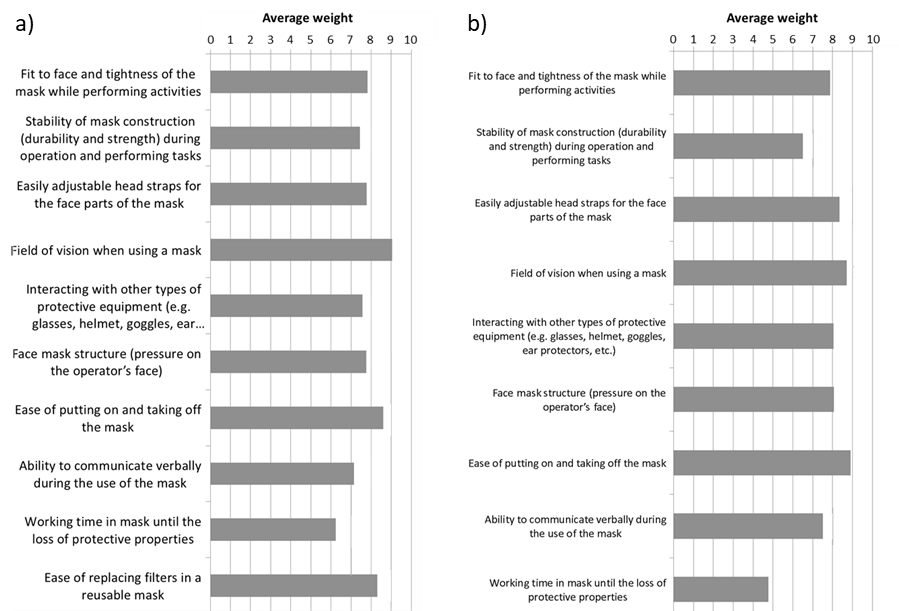
Figure 1 - a) Questionnaire responses from 137 underground workers from two Polish mining companies on the use of masks; b) Questionnaire responses from 63 underground manual workers from a Slovenian coal mining company on the use of masks. Average scores for answers out of 10, 0 was for an answer of ‘bad’, 10 was for an answer of ‘perfect’.
The Polish workers surveyed had worked underground for between 1 and 28 years, the average was 11 years. They gave the highest scores for the ‘ease of putting on and taking off the mask’ and ‘field of vision when using a mask’. The lowest average score was for the ‘working time in mask until the loss of protective properties’. Other parameters, such as fit to the face, tightness, stability of the material during work, and interface with other types of protective equipment, were thought moderately satisfactory.
The Slovenian miners gave the highest scores for the ‘ease of putting on and taking off the mask’ and the ‘field of vision when using a mask’ and had a relatively poor perception of the ‘working time of masks until they lost their protective properties’ (Figure 1b).
Whether or not the poor scores for ‘working time of masks until they lost their protective properties’ is borne-out by laboratory tests, it is recommended that workers are always given spare masks or filter inserts in preparation for their shifts.
The chemistry of inhaled coal dust, especially that of particle surfaces, is one of main controls on its toxicity. The metals identified to be of most concern in the studied coal mine dust are As, Cr, Cu, Fe, Mn, Ni, Pb, Se, Sb, Sn, Ti, V, Zn. The aim of the chemical studies was to compare the concentrations of these metals in PM10 or PM4 and PM2.5 from a hard coal mine in Poland and a lignite mine in Slovenia, and from this to make a relative assessment of their toxicity. These mining scenarios were studied and compared as they are representative of the breadth of most operational coal mining situations in Europe.
Coal dust deposition samples were size separated into PM10, PM4 and PM2.5 fractions using a specially designed and patented particle size separation device. This consists of a rotating 17 cm diameter methacrylate cylinder attached at one end to a filter sampling head through which air is drawn by a pump1. The cylinder continuously rotates to mechanically resuspend dust which is then collected on to a 0.60 μm pore-size polycarbonate filter, at an air flow rate of 25 l min−1 or 5 l min−1 to collect PM4 or PM2.5, respectively. Two hundred grams of each bulk dust sample were loaded into the cylinder to obtain 1.5-2 g of PM10 or PM4 (after 8 h) and PM2.5 (after 32 hr). The different size fractions of the coal dust samples were dissolved in acid and then analysed using inductively coupled plasma atomic emission spectroscopy (ICP-AES) and ICP-mass spectrometry (ICP-MS).
Results: The PM4/bulk dust ratios for different trace elements, i.e. the ratio of elements in PM4 compared with those in the bulk dust, are shown for underground dust samples from Poland and Slovenia in Figure 1. The ratio for Mn is less than one, both in the Polish and Slovenian samples, indicating that Mn is relatively enriched in the bulk dust. This can be explained by Mn being bound to coal particles which are more prevalent in the coarser fraction. There was also a low ratio for As in the Polish sample (0.5±0.3), for which there is currently no explanation. There were higher ratios (>1.5) for the following metals in the Polish samples: Cu (1.5±1.8), Cs (1.5±0.4) and Sb (2.6±1.5); and those from Slovenia (Fig. 4b): Ba (1.5±0.3), Zn (1.9 ±0.7), Pb (2.0±0.5), As (2.1±0.5), Sn (2.1±0.8), Cu (2.1±1.0) and Sb (3.5±1.4), indicating strong partitioning into the PM4 fraction. This likely indicates that these metals originated from small (< 4 µm) particles, possibly liberated as a result of friction and wear in mine machinery, e.g. in transporter belts or moving parts in the mine ventilation system, the latter which could have helped spread these dusts2.
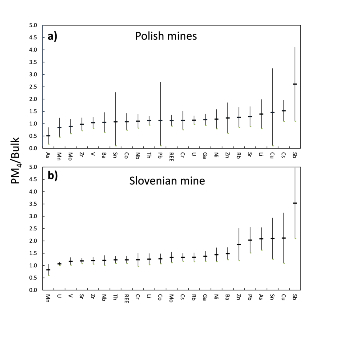
Figure 1 - Preliminary results for the distribution of trace elements between PM4 and bulk dust (PM4/Bulk) for coal dust samples collected in the ROCD project: a) for the Polish underground coal mine (n=10); and b) for the Slovenian underground coal mine (n=12). Elements are given in order of abundance along the X-axis.
From the distribution of different metals between PM2.5 and PM4 (PM2.5/PM4, Figure 2), most are slightly elevated in the PM2.5 but there are strong enrichments in this fraction for Ni (1.3±0.5), Sn (1.5±0.4) and Cu (1.5±0.7). This is interpreted to be due to these metals being sourced from mine machinery.
The relatively high PM2.5/PM4 for many of the elements shown in Figure 2, and especially for Ni, Sn and Cu, which are all potentially toxic (largely depending on their concentration and form), is worrying since PM2.5 can penetrate into the deepest regions of the lung and possibly transfer directly into the bloodstream1. This may explain the results of toxicological assessments (see relevant tab) which showed that coal dust PM2.5 from the Polish and Slovenian case study mines is relatively toxic compared with PM10. In reality, it is likely to be far more complex than this, governed at least partly by the bioavailability of the different elements and the possible presence of a variety of other inorganic and organic species. Whatever the cause of the toxicity, these observations emphasise the need to monitor PM2.5 in addition to PM4 and PM10. To re-emphasise, from urban air pollution studies, increased atmospheric concentrations of PM2.5 have been linked to higher rates of cardiovascular and respiratory mortality3,4; we do not yet know if coal dust PM2.5 may have a similar effect.
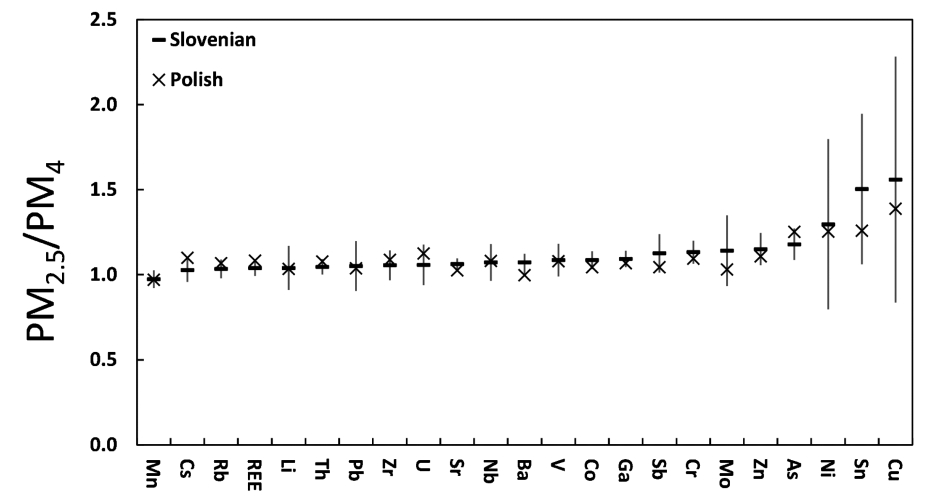
Figure 2 - Preliminary results for the distribution of trace elements between PM2.5 and PM4 (PM2.5/PM4) for coal dust samples from Polish mines (n=7 samples) and one Slovenian mine.
- Moreno, T., Trechera, P., Querol, X., Lah, R., Johnson, D., Wrana, A. and Williamson, B., 2019. Trace element fractionation between PM10 and PM2.5 in coal mine dust: implications for occupational respiratory health. Int. J. Coal Geol., 203: 52–59. (see references therein)
- Chen, X., Hu, H., Xu, Y., Zhang, Y. and Yang, G., 2015. Experimental investigation of foam dedusting agent in underground coal mine. Mater. Res. Innov. 19: 508–511.
- WHO, 2013. Health effects of particulate matter: Policy implications for countries in eastern Europe, Caucasus and central Asia (ISBN 978 92 890 0001 7).
- Liu, C., Chen, R., Sera, F., Vicedo-Cabrera, A.M., Guo, Y., Tong, S., Coelho, M.S.Z.S., Saldiva, P.H.N., Lavigne, E., Matus, P., Valdes, O.N., Osorio Garcia, S., Pascal, M., Stafoggia, M., Scortichini, M., Hashizume, M., Honda, Y., Hurtado-Díaz, M., Cruz, J., Nunes, B., Teixeria, J.P., Kim, H., Tobias, A., Íñiguez, C., Forsberg, B., Åström, C., Ragettli, M.S., Guo, Y.-L., Chen, B.Y., Bell, M.L., Wright, C.Y., Scovronick, N., Garland, R.M., Milojevic, A., Kyselý, J., Urban, A., Orru, H., Indermitte, E., Jaakkola, J.J.K., Ryti, N.R.I., Katsouyanni, K., Analitis, A., Zanobetti, A., Schwartz, J., Chen, J., Wu, T., Cohen, A., Gasparrini, A., Kan, H., 2019. Ambient particulate air pollution and daily mortality in 652 cities. N. Engl. J. Med., 381, 705-715.
The particle size and shape characteristics and mineralogical composition of coal dust PM4 and PM2.5 were determined using QEMSCAN®. This is an automated mineralogical analysis system which is based on a scanning electron microscope with energy dispersive X-ray detector(s). For QEMSCAN® to recognise coal particles, a new protocol was developed whereby samples were prepared as particle dispersions on polyethylene substrates. Polyethylene was used as particle demarcation requires a brighter backscattered electron signal (nominally a higher average atomic number) than their substrate. Once recognised, each particle was subject to elemental analysis in a grid pattern with an analytical point spacing of 0.5 µm.
The energy dispersive spectra from each point of analysis was automatically compared with a database of mineral and phase spectra to assign a mineral name. The data was output as individual particle mineral maps, and for each sample, particle size and shape information, modal mineralogy, particle surface mineralogy1 and mineral associations data. For each sample, QEMSCAN® was configured to measure 100,000 particles which required approximately 10 hours of analysis time.
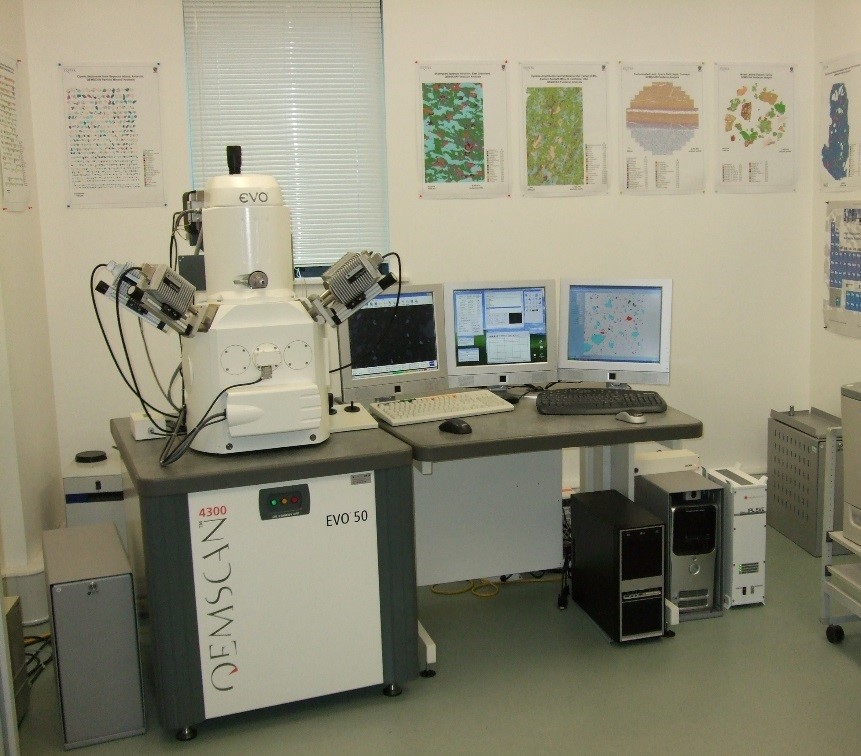
Figure 1 - QEMSCAN® automated mineralogical analysis system which can determine the size, shape and mineral associations of up to 100,000 dust particles in 10 hours
From initial analyses of mine dusts (results in Figure 2), PM4 and PM2.5 samples from a Polish hard coal mine contained higher concentrations of quartz and Ti-phases compared with those from the Slovenian lignite mine, which were relatively enriched in sulphide/sulphates, Fe-phases, gypsum/anhydrite, salts and fly-ash. How this may link to the relative toxicity of the dust and risk to mine workers will require further studies, however, the mere presence of fly ash and minerals such as quartz in the coal dust PM, particularly in the PM2.5 fraction, is cause for concern. The higher concentrations of quartz in the Polish vs Slovenian PM2.5 may, at least partly, explain their higher toxicity in some of the toxicological tests (see relevant tab). The developed QEMSCAN® method has excellent potential for the quantitative mineralogical assessment of coal and other mixed dusts in studies of their toxicity and to aid in the efficiency testing of new dust control systems.
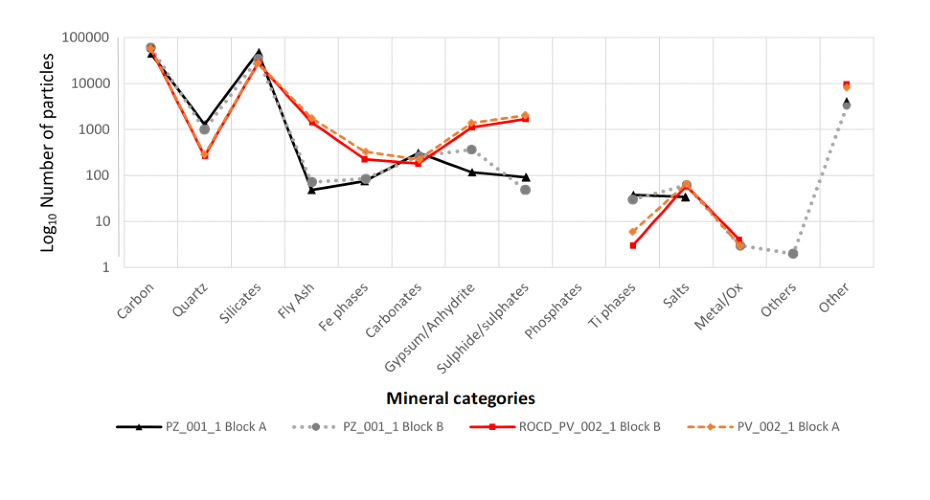
Figure 2 - Plot of QEMSCAN® data comparing particle numbers (log10 scale), out of 100,000 particles analysed (i.e. representing relative concentration by particle number), of mineral categories in coal dust PM2.5 from Poland (PZ_001_1 Block A and PZ_001_1_ Block B) and Slovenia (PV_002_1 Block A and PV_002_1 Block B). Repeated analyses were undertaken of the same sample preparation (Block A and B) to give an indication of inter-sample variability.
- Williamson, B.J., Rollinson, G. and Pirrie, D., 2013. Automated Mineralogical Analysis of PM10: New Parameters for Assessing PM Toxicity. Environ. Sci. Technol., 3, 47, 5570−5577.
Tests were undertaken to determine the damage caused by PM10 and PM2.5 to human lung cells cultured in the lab. In general, both coal dust PM10 and PM2.5 from the Polish and Slovenian mines were found to be toxic and increasingly so at higher concentrations. As an example, Figure 1 shows the results of a toxicological experiment to determine the impact of PM10 and PM2.5 on the ‘health’ of a certain type of cultured human cells. With increasing concentrations of PM10 and PM2.5 there was a decrease in cell viability (‘health’), in much the same was as for quartz mineral dust and coal fly ash which are known to be toxic to humans. In addition, for both the Polish (PZ_) and Slovenian (PV_) samples, coal dust PM2.5 caused a stronger decrease in cell viability than the corresponding PM10 fraction. In most tests, the Polish coal PM10 and PM2.5 caused a greater decrease in cell viability than Slovenian equivalents, however this was not always the case. This is surprising as, from the mineralogical assessment, the Slovenian coal dust PM2.5 contained a higher proportion of fly ash, which probably contains relatively high levels of potentially toxic metals. However, the polish samples contained a higher proportion of quartz which is a known toxin. The variability in results from the different tests is probably due to some being more sensitive to certain toxins than others, and the chemically and mineralogically complex nature of the PM10 and PM2.5, with the presence of multiple toxins such as certain transition metals, e.g. Fe, As, Cr, Cu, Fe, Mn, Ni, Pb, Se, Sb, Sn, Ti, V and/or Zn, minerals such as quartz and organic-based substances. The exact reasons for the differences in toxicity between the Polish and Slovenian samples therefore remains unclear.
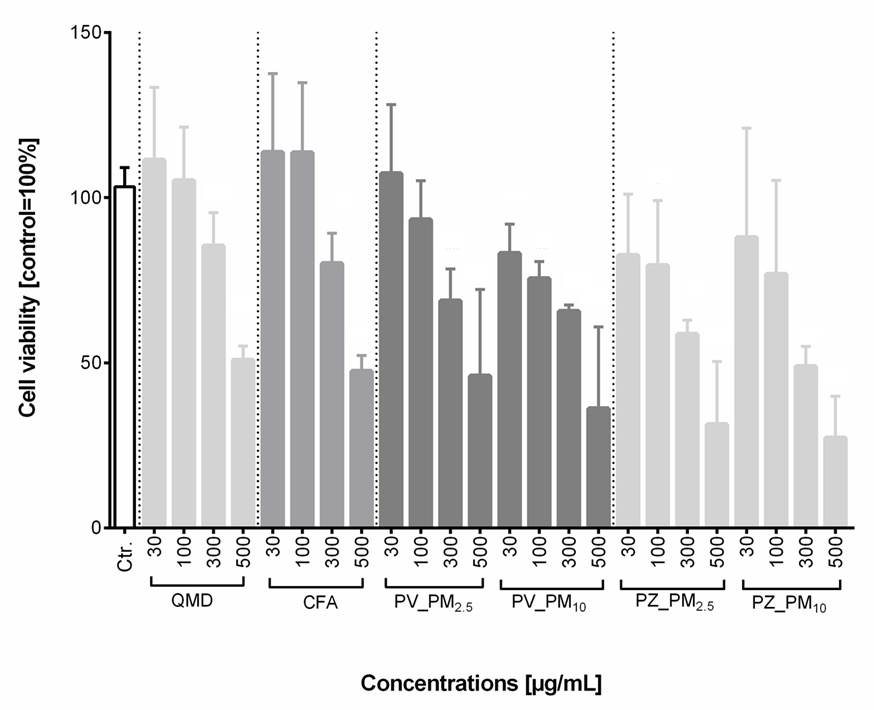
Figure 1 - Results of tests (WST-1 assay) on human monocytic cells to determine the acute toxicity of different concentrations (30, 100, 300, 500 mg/mL; 24 h exposure) of coal dust PM10 and PM2.5 from the Polish (PZ_) and Slovenian (PV_) mines. The negative control (Ctr.), with no exposure to toxins, gave a value for cell viability of approximately 100%. At increasing concentrations of the positive (toxic) control substances QMD (quartz mineral dust) and CFA (coal fly ash), and the coal dust PM10 and PM2.5 from Poland and Slovenia, there was a substantial reduction in cell viability. Each bar represents the data for the mean (±SD) of three independent experiments performed in triplicate.
Two new devices for monitoring dusts underground were developed to prototype stage, the EMIDUST continuous dust monitor and the DMIex continuous monitoring and integrated gravimetric dust sampling device. Both have been ATEX-certified which means they can be operated in potentially explosive environments underground.
The EMIDUST device (Figure 1) is designed for continuous measurement and recording of rapid changes in the concentrations of dust (PM2.5 and PM10) in air during the operation of mining machines, at transfer points, on the routes of transport of extracted materials and in dust-generating processes in general. It was specifically developed for use in methane and/or coal dust explosion hazard areas. It is portable and can be suspended in any safe place in an underground mine where it is possible to supervise its operation. EMIDUST should be mounted within the current of the air carrying the dust (the axis of the chamber parallel to the direction of the flowing air) in places indicated by the Ventilation Department Manager.
The advantage of EMIDUST is the real-time measurement of dust concentrations and its use with other mine monitoring or dust suppression systems, e.g. the SSD-1 dust control spraying device developed within the ROCD project.
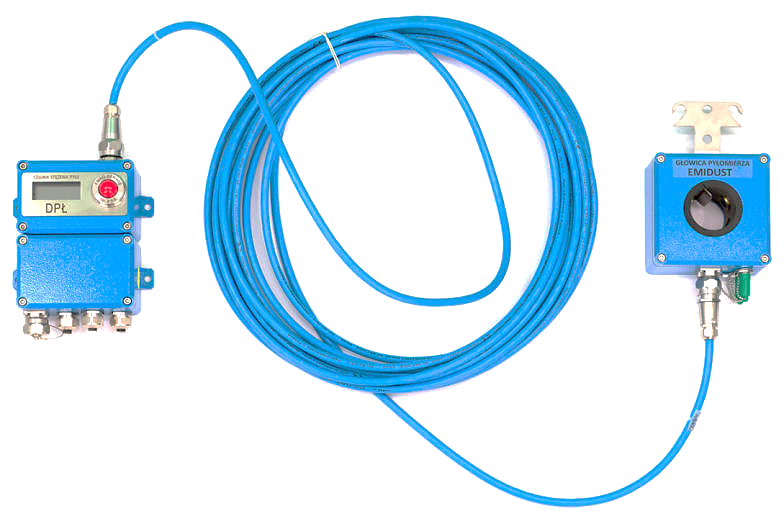
Figure 1 - EMIDUST continuous dust monitoring device.
The DMIex dust monitoring and collection device (Figure 2) combines a commercially available dust sensor with a cascade-impactor for gravimetric measurement of dust concentrations (PM10 (Stage1) and PM4 or PM2.5 (Stage2)) and dust collection for physicochemical characterisation. For continuous measurement, a portion of the dust is diverted into the dust sensors via adjustable air adaptation chambers. The measuring, processing, storage and transmission electronics ensure the appropriate treatment of dust concentration, temperature and humidity data from the respective adaptation-chambers.
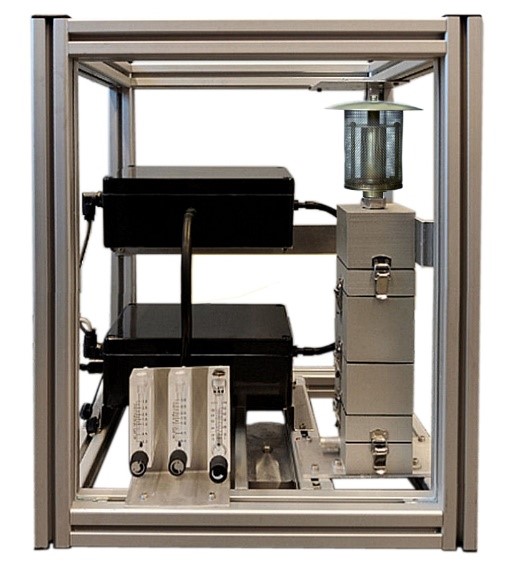
Figure 2 - Prototype of new dust-meter DMIex.
Benefits of the DMIex device over previously available systems:
- Time-accurate and continuous measurement of dust, temperature and humidity.
- The measurement accuracy of the inexpensive commercially available dust sensors is enhanced by regular comparison with gravimetric (physically weighed) measurements of dust collected in the impactor.
- The impactor is designed in such a way that even in harsh underground conditions the impactor collection medium can be exchanged cleanly (i.e. with little chance of contamination).
- With a high impactor throughput of 50 l/min, it is possible to collect particles in the fractions PM4 and PM2.5 in a relatively short time.
The most common way to control airborne dust in underground coal mines is to use water spraying systems and dust collectors. In the case of spraying systems, these can be placed where dusts are generated or where their concentrations are high, such as at conveyor transfer points or close to longwalls. Their current shortcomings are that water flow rates cannot be adjusted to specific dust concentrations and the use of standard spray nozzles, at recommended flow rates, does not efficiently remove particles <25 μm in diameter, let alone PM2.5. To address this, a new ‘smart’ dust spraying device, the SSD-1, has been developed for coal dust PM10 and PM2.5 (Figure 1). This can use information from simultaneous dust concentration measurements (e.g. using the EMIDUST device, see relevant tab) to set 9 combinations of water and compressed air pressures to create suitable amounts and sizes of water droplets to optimise the capture of airborne PM10 and PM2.51.
The prototype SSD-1 spraying device has been shown to be around 10% more effective in reducing respirable and inhalable dust concentrations and it consumed less water than currently used devices. An additional advantage is its adaptability in being able to automatically adjust its spraying intensity to the current level of PM10 and PM2.5. This allows optimal spraying conditions to be achieved in terms of reducing dust and minimising water consumption. The SSD-1 system underwent a successful trial in the "Pniówek" mine, Poland, receiving very positive feedback from mine workers. There was a significant improvement in air quality in the area where the device was installed. This capability was confirmed by additional tests carried out after the completion of the ROCD project.
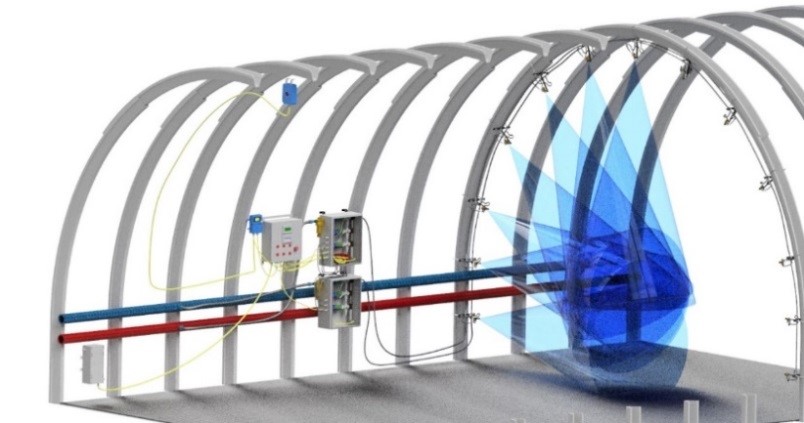
Figure 1 - Illustration of the SSD-1 underground mine spraying installation for dust control.
Other commonly used dust control systems are dust collectors. These are mainly used for dedusting air behind the roadheader during its operation, as illustrated in Figure 2. They work by pressing or sucking dust-laden air into an inlet unit, spraying droplets of water to capture dust particles, allowing the water-dust droplets to deposit out, and returning cleaned water to the spraying system of the dust collector. In most current systems, water droplets are created by water being introduced into a spinning rotor driven by an electric motor. The water is expelled radially through the holes in the rotor's flange by the action of centrifugal force which creates a water curtain for dust capture. In the new collector system, the rotor has been replaced by a dispersion section which is made of intersecting metal sheets which creates square inlet openings with rectangular outlets. The inlet stream containing airborne dust, which is initially dispersed, reaches the square-shaped inlet openings forming its own partial stream. Each opening has converging walls in which the partial streams are accelerated due to a gradual narrowing of cross-sectional flow. The exit rectangles of neighbouring sections are perpendicular to each other so that the partial streams mix turbulently which causes water droplets to collide with and capture dust particles. From laboratory tests, the new system had a dust removal efficiency of up to 99.7%2. From this, we can conclude that the use of dispersion sections will allow more efficient dust collection than in systems based on rotating nozzles.
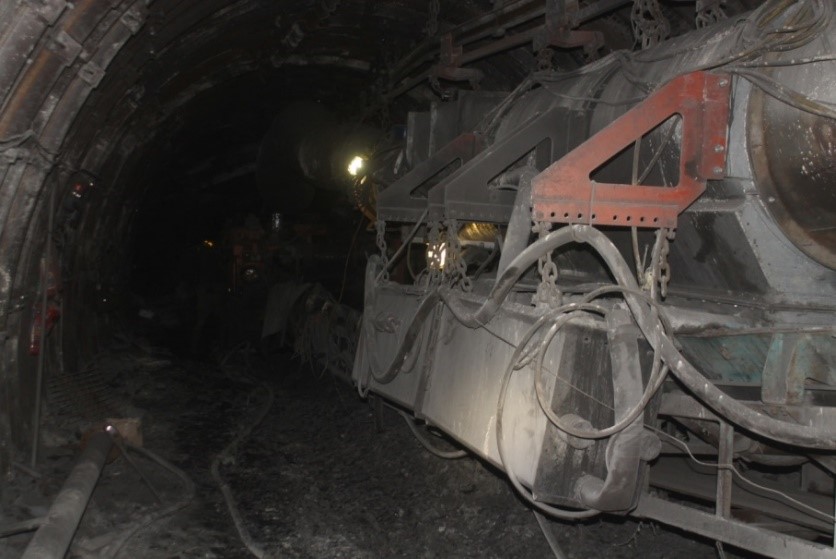
Figure 2 - Dust collector OD-1000/1000 in the Knurów underground mine.
- Bałaga, D., Siegmund, M., Kalita, M., Williamson, B.J., Walentek, A., Małachowski, M., 2021. Selection of operational parameters for a smart spraying system to control airborne PM10 and PM2.5 dusts in underground coal mines. Process Saf. Environ. Prot., 148: 482-494.
- Jedziniak, M., 2013. "Badania procesu mokrego odpylania powietrza z kopalnianego wyrobiska chodnikowego za pomocą odpylacza dyspersyjnego", praca doktorska, Politechnika Śląska, wrzesień 2013, (“Research of wet dedusting of mine workings using a dispersive dust collector”, doctoral dissertation, The Silesian Technical University, September 2013).Kenny, L.C., Hurley, F., Warren, N.D., 2002. Estimation of the risk of contracting pneumoconiosis in the UK coal mining industry. Ann. Occup.
Experiments were carried out to improve the performance testing of currently available dust masks to allow mining companies to make the best choice of equipment for their workers. Masks for use in underground coal mines are divided into three basic categories, based on their efficiency: FFP1 which captures about 80% of particles that are not smaller than 2 µm, FFP2 which captures about 94% of particles that are not smaller than 0.5 µm, and FFP3 which captures about 99% of particles that are not smaller than 0.5 µm. Testing was carried out on the FFP2 and FFP3 class of dust masks, from a number of different suppliers, which are officially approved for use (having appropriate certificates) in areas of underground mines with high dust concentrations. RPE placed on the market is tested in accordance with standard EN 149 + A1: 2010 [1].
An experimental test stand constructed in the ROCD project (Figure 1) allowed an assessment of the filtration efficiency of different types of half mask. It is equipped with a dust chamber, artificial head inside the chamber, artificial lung, climatic chamber, and DustTrak™ unit for the measurement of dust concentrations inside the chamber and in inhaled air.
The masks were assessed using three types of test:
- Testing of masks strapped to the artificial head.
- Testing of masks sealed onto a special base.
- Testing of piece of filter material glued onto the special base.
.jpg)
Figure 1 - Test stand for assessing the performance of dust masks and filters. Note the test dummy head which is wearing a mask in the experimental chamber. The artificial lungs are shown on the right.
Different rates of breathing were assessed which relate to different levels of physical activity: rest (12 breaths per minute), effort (25 breaths per minute), and hard work (60 breaths per minute).
Breathing resistance was measured four times. Firstly at the beginning, when the mask was new and clean and then at:
- 1100 cycles at rest breathing rate
- 1100 cycles under effort
- 1100 cycles under hard work
Additional tests on the efficiency of the filter material used in masks (i.e. removing the effects of leaks around the mask) were carried out using an auxiliary test stand. For this, pieces of the filter material were glued over a hole in a special suction box. The box was situated on the dust chamber and connected by a pipe to the measuring equipment on the main stand. Only one cylinder of the artificial lungs was used for sucking the air from the chamber through the piece of filter. For each filter, 240 cycles were undertaken using 500 ml for each ‘breath’ and 12 breaths/min (rest mode).
Eight types of half masks were tested during the ROCD project (Table 1), two from the mining companies JSW, two from PGG and one from PV. Additionally, 3 masks used by KOMAG’s workers (KOM) were also tested to gain more data.
Table 1 - Masks and filters tested with the newly developed test stand.
| Mining co. | Mark of the mask containing filter type mark | Mask type | |
|---|---|---|---|
| 1. | JSW | FS-21V FFP2 NR D | Bowl type disposable |
| 2. | JSW | X310SV FFP3 NR D | Bowl type disposable |
| 3. | PGG | ZF 0/27z FFP3 NR D | Foldable disposable |
| 4. | PGG | EKO 54V FFP2 NR D | Foldable disposable |
| 5. | PV | MOLDEX 2365 P1 NR D | Bowl type disposable |
| 6. | KOM | 3M Vflex 9152R FFP2 NR D | Foldable disposable |
| 7. | KOM | SECURA 3000 / filter SECAIR 2000.03 P2 R | Reusable |
| 8. | KOM | SECURA 2000 / filter SECAIR 2000.03 P2 R | Reusable |
Example results from the breathing resistance tests are shown on Figure 2. The magnitude of the under-pressure (negative pressure, Pa) was relatively low for rest and effort breathing rates and therefore, in general, the breathing resistance of the masks can be said to be satisfactory in most circumstances. Worryingly, the breathing resistance for the ‘hard work’ rate was considerably higher for some types of masks. This should be taken into account during the selection of dust masks for hard work activities.
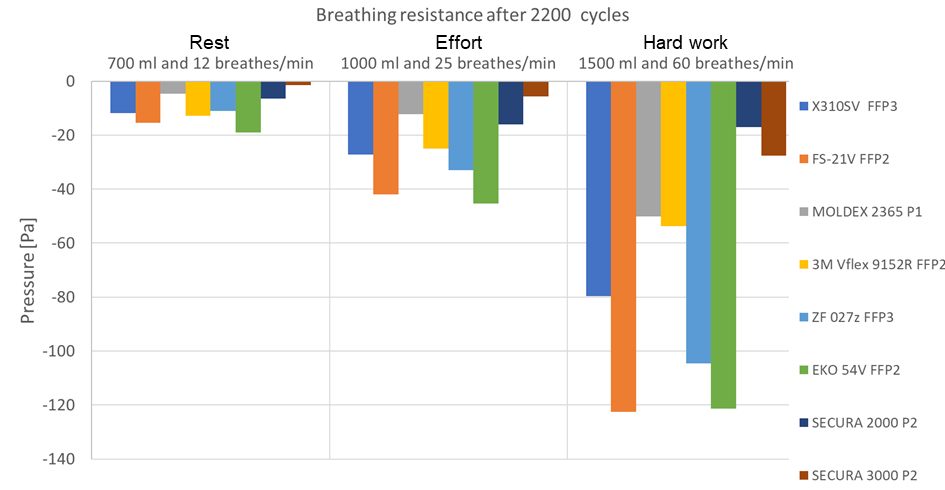
Figure 2 - Graph comparing breathing resistance (negative pressure) after 2200 cycles for the three breathing rates.
The next parameter to be assessed was filtration efficiency, see results in Figure 3. It can be observed that for each type of filter, filtration efficiency did not decrease noticeably when the number of breathing cycles increased up to 3300. There were, however, substantial differences between the efficiencies of the different masks. The reusable mask filter FFP2 had a much lower efficiency compared with the FFP1 which is used in the Velenje mine (PV, MOLDEX 2365 P1 NR D); this was surprising. The lower graph in Figure 3 shows the average filtering efficiency of different masks for different dust size fractions. The efficiency of the masks for PM1 and PM2.5 was always a little bit lower than for PM4 and PM10. In conclusion, it is clear from the data in Figures 1 to 3 that a good knowledge of the particle size range of the coal dust and the nature of the work to be performed in a particular operation is needed in order to choose the most appropriate types of dust masks.
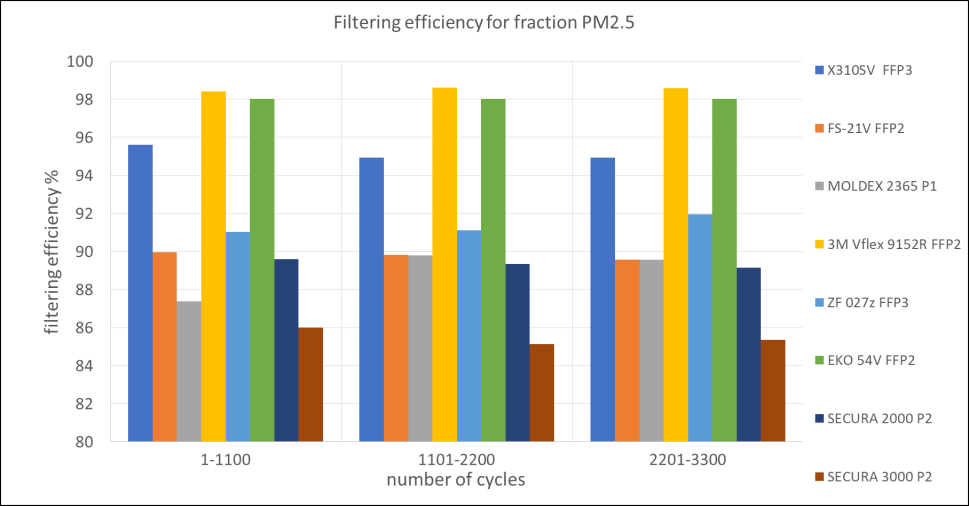
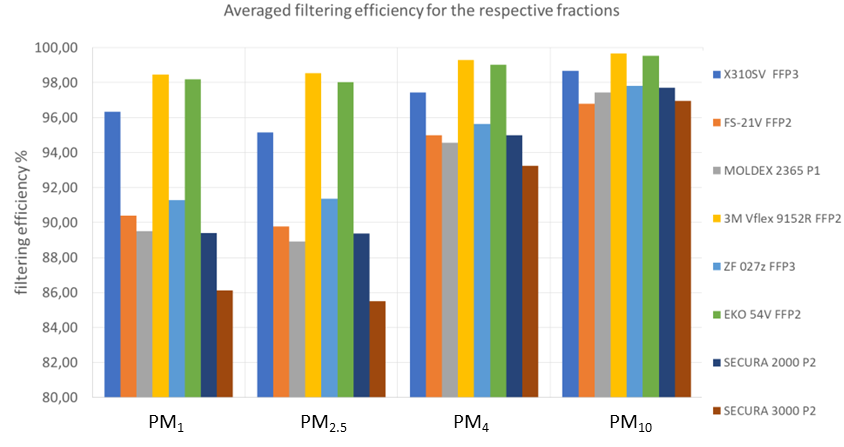
Figure 3 - Graph comparing the filtration efficiency of the tested masks, upper graph for PM2.5 (for different masks and different numbers of cycles in the procedure) and lower graph for the filtering efficiently of the different masks for the different size fractions.
The use of masks is vital for reducing worker exposure to coal dusts. In theory, they should work well for most types of dust, including PM2.5. Their performance in the workplace, however, is generally much poorer than suggested by manufacturers’ literature. This is because their effectiveness depends on whether they are fitted and worn correctly which can be compromised if the worker adjusts the mask to make it more comfortable, to fit it around other equipment such as glasses, or does not replace their mask or mask filter regularly. Another important aspect is that workers may sometimes only wear their masks when they visually or otherwise sense high dust concentrations, which will be mainly due to the presence of relatively coarse particles, and less so when there are imperceptibly high levels of invisible PM2.5.
As a result of the ROCD project, an online e-training course (available in English and Polish) and other materials have been developed to promote a greater awareness of coal dust hazards and how to deal with them, including how to wear masks properly and the importance of their constant use underground. The main target audiences are those involved in the control of dusts in coal mines, mine workers exposed to dusts and mining authorities and legislators.
The ROCD course ‘Dust hazards in mines and ways to reduce their impact’ incorporates learning materials of various kinds including PowerPoint presentations, software tools, quizzes, a glossary of terms, films and downloadable pamphlets and instructional materials. Most of these have been made available through a Moodle platform which is ideal for the creation of quizzes. The films are available freely via our YouTube channel. The structure of the ROCD course is presented in Figure 1.

Figure 1 - Structure of the ROCD training materials hosted on Moodle.
The glossary within the course covers more than 50 terms regarding dust hazards which are in accordance with relevant standards, regulations and other considered sources. Module 1 ‘Introduction to dust hazards’ provides fundamental knowledge regarding dusts (not only coal dusts) including where within mines dusts are “produced”, how coal dust enters and affects the human respiratory system, and pneumoconiosis as the most common of the serious diseases associated with coal dust. Module 2 ‘Dust hazards prediction’ provides knowledge about sample devices used for measuring dust levels, and gives access to an online application that describes the distribution of dust concentrations which depends on: i) the distance from the source and ii) the use of spraying systems. Module 3 ‘Dust hazards prevention’ focuses on the types of solutions that can be used to reduce dust concentrations in different areas of coal mines. Module 4 ‘Dust hazards protection’ provides comprehensive information about half-masks and their correct use.
Following the completion of the modules, the user moves on to work with interactive and multimedia materials which are designed to reinforce their knowledge and understanding. These include: i) 3 playlists of films hosted on the ROCD YouTube channel, ii) interactive Moodle ‘quizzes’, and iii) a serious game app called ROCD Miner which can be downloaded and played on Android devices.
The most notable features of the ROCD e-training course are:
- access to the course and to the YouTube channel is unlimited and free;
- there is no compulsory order of learning, i.e. any content can be accessed at any time – the learner controls the process, they can work at their own pace, skip content if they are comfortable to do so and recap whenever they choose; and
- individual components of the programme can be used as part of organised workshops or training events.
Apart from training materials, a number of awareness raising and outreach tools have been developed under the ROCD project. One example is the set of four posters shown in Figure 2, which can be placed in different areas of mines (canteens, toilets, changing rooms, elevators, rest areas etc.) to remind workers to always wear their masks. Some of these were designed to be ‘hard hitting’, similar to infographics used on cigarette packets, i.e. as is appropriate for the terrible potential consequences of not correctly wearing a dust mask underground. Materials designed to raise awareness amongst school children and teenagers were also designed to more gently embed understanding of the risks at an early age; these can be downloaded from our website.
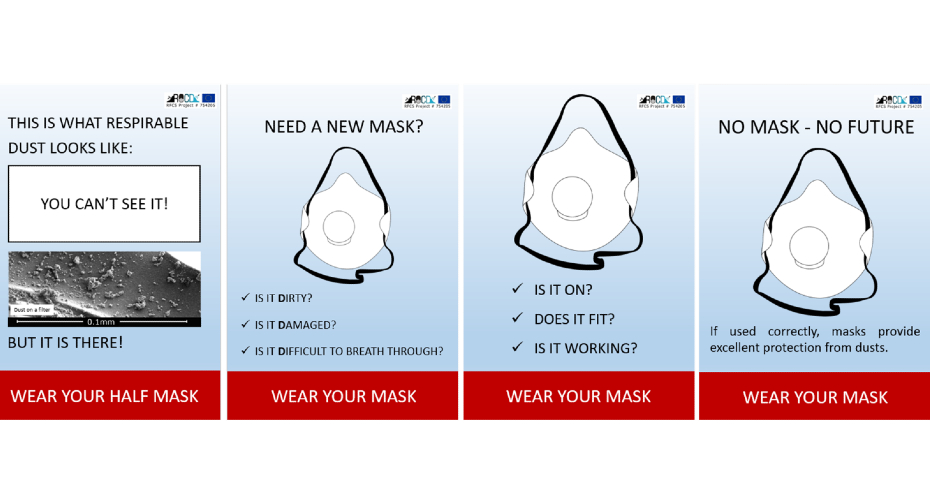
Figure 2 - Workplace posters created during the ROCD project to encourage workers to wear their dust masks. The posters have been translated into Polish and Slovenian and made available to mining companies.
Concluding remarks
The ROCD project has provided a modern reassessment of the nature and toxicity of coal dust PM10, PM4 and, for the first time in a major European study, PM2.5 which may be contributing to cardiovascular as well as respiratory diseases in miners. This has included the development of a particle size separation device for inhalable coal dusts, and a new methodology for assessing their mineralogical composition. In addition, two new monitoring and two new dust control devices, and a new protocol for the testing of dust masks have been developed to prototype stage. The results of the ROCD project are being disseminated globally via our dedicated website, including a list of publications from the work and links to e-training materials for best practice in the use of dust control systems and respiratory protective masks. It is hoped that these endeavours will help reduce worldwide incidences of coal mine dust-related diseases.

